Diamer Basha Dam: An eclipse to ancient Buddhist heritage
With these regional issues of national concerns to both India as well Pakistan, the problem of significant ancient Buddhist rock arts vanishing because of the dam is a global loss and should also be brought into global attention.
Total Views |
Ever since Pakistan and China officially shook hands regarding the long standing proposal of the Diamer – Basha Dam which is to be built on the river Indus, there have been several objections raised around the world as it has endangered an ancient Buddhist monument; a potential UNESCO world heritage site. The accord of construction of the Diamer Basha dam was signed in 2020 between China’s state – run Power China Company and Pakistan army’s commercial body Frontier Works Organization (FWO) with an estimated completion of the project by the year 2028.
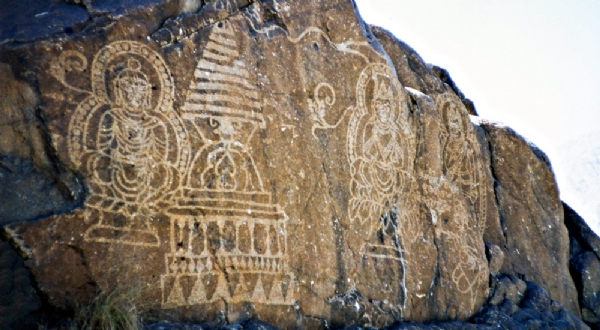
Apart from the number of practical loopholes that the plan already has, the fact that the project is going to destroy the heritage of ancient times has been emphasized over and over again with no fruitful response from the global heritage conservation communities. The entire region of Gilgit Baltistan is rich in Petroglyphs and Epigraphs from the ancient period. The success of the project will end up with significant loss of valuable historical data that these monuments provide. The locals of Gilgit Baltistan have taken it to the social media several time and also continue to protest against the project to share their voices against Pakistan govt's ravaging decision.
Petroglyph near the Karakoram Highway, Gilgit Baltistan
The Diamer – Bhasha Dam project is going to play a vital role for China Pakistan Economic Corridor (CPEC). Therefore, it will prove to be a significant investment for China with productive outcomes. But how profitable is the project going to be for Pakistan is a question that persists forever because of the numerous problems which will be associated with the project, rather the problems that have already disturbed the locals' lives. Questions have also been raised from time to time regarding the safety of the villages in the Gilgit Baltistan region by officials of Pakistan Occupied Kashmir.
Perhaps, that has always been the reason why this project has taken 40 years to actually come into progress. However, all the concerns have always been ignored by the govt. The problem of destruction of the Petroglyphs along the Karakoram Highway is the lowest among the concerns shown by the officials, but it definitely was flagged. But the local residents of the region keep on stressing the problem. The fact that these Petroglyphs are not just monumental heritage of the Indian Subcontinent but of the entire world is yet shadowed. As a result of ignorance to such significant monumental group, the world will be soon bidding a farewell to such ancient Buddhist treasure.
What are Petroglyphs?
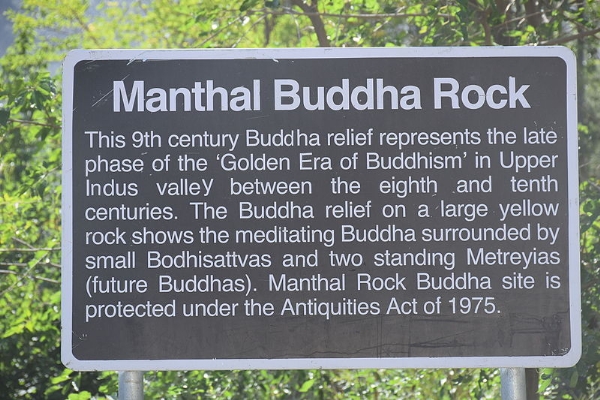
Manthal Buddha Rock, Skardu Baltistan
Before we start with the problem of Petroglyphs found in the concerned region, first let us understand what this rock art actually is? A petroglyph is simply an image that is carved into a rock. Anything of historical context that has been carved by humans on rocks available around them is considered to be an attempt of those humans to record the things happening around them. These carvings resemble the lifestyle of the contemporary human society in the simplest symbolic art possible. Therefore, they provide huge deal of information.
Petroglyphs attribute to a specific group of people who may have inhabited or have passed through the area where the petroglyphs occur. Thus, just like other historical devices such as coins, inscriptions, seals and others, Petroglyphs too provide significant information about the ancient people. The Petroglyphs found in this area have been classified into four categories by Archaeologist Dr. Ahmad Hasan Dani, with the oldest one dating from two millennia BC.
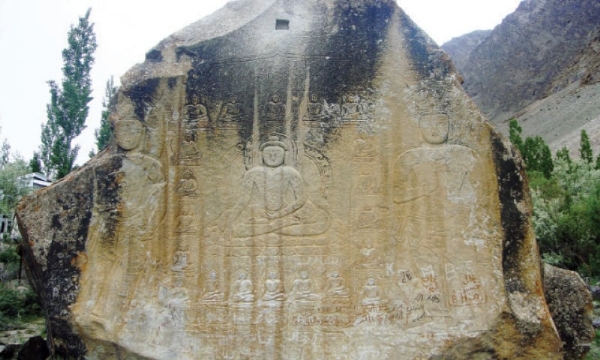
These are mainly Buddhist rock carvings and can also provide potential tourism if not neglected. Spiritually, the carvings are of immense importance to Buddhism. And therefore, the negligence of these petroglyphs also made the Dalai Lama call for its preservation. When the Dalai Lama came to know about the ignorance that these rock carvings of the Kushan as well as Bronze Age have been facing, he had appealed publicly for its preservation.
What is the global historical importance of GB?
Gilgit – Baltistan is located where the Hindu Kosh, Karakoram ranges and the Himalayas concur. Thus, the geology and geography of the region itself is evident enough to understand the historical significance of the region.
The entire region of Gilgit Baltistan was an important section of the ancient Silk route which connected western cultures to the ones on Asian land, up to China. GB has always been an important gate for the Indian Mainland into Central Asia and vice versa. That precisely explains the strategic importance of the region even today and explains all the geo political tensions around the region. The region since long time in history has been a part of the Indian mainland and therefore has been a witness of spread of culture, religion and trade from India to the rest of the world and also of the things which came into India. That precisely is one of the reasons why India claims GB to be Indian land and calls the Diamer – Basha Dam project as illegal.

The geo – politics around the region is quite strangled and this might not be enough to explain it. But it is enough to explain the historical importance of the region. There are scattered portraits of petroglyphs throughout entire GB, with many of them yet undocumented. Most of these Petroglyphs are inscriptions in Kharoshti and Brahmi scripts; the scripts that hold huge treasure of Buddhist history. Petroglyphs are observed around the main rivers of the region; Indus and Gilgit, through where today’s Karakoram highway makes its way.
Most of the rock carvings are concentrated between major Buddhist archaeological sites of Hunza and Shatial, few more have been found around the areas of Skardu and Shigar. A deeper study of these Petroglyphs and carvings will facilitate us with better understanding of the functioning of ancient trade routes. Preservation of these Petroglyphs is necessary not only for the History of the Indian Mainland but as it contributes great chunk of history of ancient world, the place needs global attention.
Since how long has this issue being ignored by the Pakistan government? It is not today that suddenly concerns have been raised by the local people about the destruction of such ancient heritage. The Diamer – Basha project has been in discussion of the Pakistan Government since a long time. And there have been many incidents where the Government was made aware of the crucial situation of the Buddhist rock carvings. The construction of dam in the prescribed region is going to cost a tragedy for Pakistan and the global Buddhist community. However, the Pakistan government seems to have turned a blind eye since a long time to the repercussions which will be caused because of the dam.
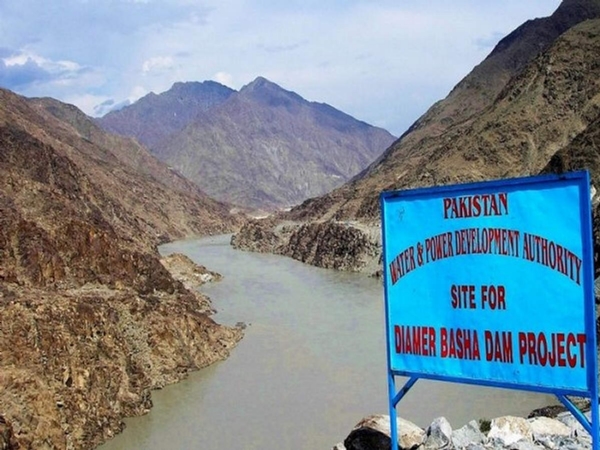
In 2004, a letter was written by the original designer of the dam, General Butt, to the then Pakistan President Pervez Musharraf that stated, “I shudder at the thought of earthquake effects on Basha. Dam-burst would wipe out Tarbela and all barrages on Indus; which would take us back to the stone-age.” There are instances even after Gen Butt's attempt to raise flags against the construction when the government was warned about the devastating effects of the illegal construction. Although nowhere was the issue of the Buddhist rock carvings put forth directly, but it was pretty clear that as the region will be devastated with earthquakes and seismic activities triggered due to construction of the dam, eventually the rock art too will be destroyed and later buried under the dam reservoir.
The locals have for a long time depended on social media to bring the matter into people’s attention. Things grabbed the attention of international media in 2020 when ‘The Statesman’ published what one of the residents was trying to say. According to the Statesman, "A resident of the area, Araib Ali Baig, wrote, The art of rock carving is present in all regions of Gilgit Baltistan, mainly in the districts of Diamir, Hunza and Nagar and Baltistan. Speaking specifically of Baltistan, these engravings can be seen on former settlements and popular old routes along the Indus and Shyok”. The project will destroy a number of petroglyphs that are the talking rocks of the region, read another comment. Unplanned development activities, commercial painting practices, chalk on the walls, hatred of local people for these pre-Islamic sculptures and apathy from government departments have also led to the rapid disappearance of these historic rock art, said a comment.
Baig commented, “Inscriptions which were destroyed during the conversion of the local population to Islam in the 14th and 15th centuries AD. Even today, these inscriptions are easy to find in the villages located mainly on the east bank of the Indus, but they are in a state of disrepair." "Yes these sculptures belong to Buddhism. They can attract millions of tourists across the globe. Irrespective of religion we should preserve this ancient heritage”, commented another resident of Kashmir.
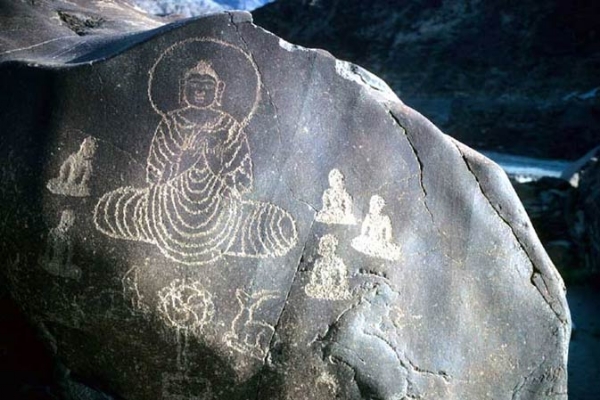
The Pakistan Government has always seemed to be inconsiderate of the residents of PoK, what they call 'Azad Kashmir'. The case of Diamer - Basha dam is a similar situation. And for a govt which is least bothered of its people, there’s hardly any room to expect them worrying about things like history, monuments and heritage. Clearly, the only nation which will be benefitting from the project will be China. The construction of the dam is capable of flooding the Karakoram Highway and putting around 35,000 local residents into a position of
helplessness.
Other than the fact that the dam will be constructed on Indian land illegally, there are claims that the dam will cause water shortage in the Ladakh region. With these regional issues of national concerns to both India as well Pakistan, the problem of significant ancient Buddhist rock arts vanishing because of the dam is a global loss and should also be brought into global attention.


